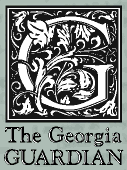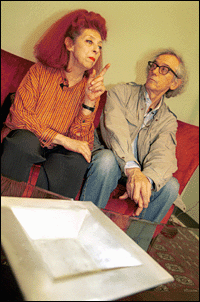


SCAD hosts Christo and Jeanne-Claude

Photo by Russ Bryant
Christo (right) and Jeanne-Claude (left) spoke at the Savannah College
of Art and Design Sept. 30 in conjunction with two on-campus exhibits.
By Christina Taylor
(from 10/8/99 issue)
Their works curtain valleys, wrap buildings, and dot country-sides. They are passionate, driven people who live only to see their large-scale projects come to fruition.
They are Christo and Jeanne-Claude, the artists responsible for works like "The Umbrellas," "Valley Curtain," "Wrapped Reichstag," and "Surrounded Islands." For the next few months, Christo and Jeanne-Claude's posters, lithographs, collages, photographs and works in progress will be on display in two Savannah College of Art and Design exhibits, "Projects and Installations" at the Exhibit A Gallery and "Two Works in Progress" at the Pinnacle Gallery.
On September 30, the artists came to the Trustees Theater to give a lecture and answer questions about their works and lives. The lecture, which was free and open to the public, attracted an overflowing crowd of students, professors and other art lovers anxious for a chance to meet Christo and Jeanne-Claude in person and hear a little bit about their work.
The lifestyle that Christo and Jeanne-Claude described in the lecture and interview sessions is one governed by art. Other concerns like money and public acclaim are inconsequential to the artists.
"The works that we create are works of art, of joy and beauty which we create for us, not the public," said Christo and Jeanne-Claude.
Because Christo and Jeanne-Claude have such an intense desire to see plans for their works come to life, they pour all of their money into their art-work.
"We are not in the success business, we make works of beauty," they said.
Christo and Jeanne-Claude make millions from their smaller collages and other works, selling them from their studio to collectors and museums. However, despite this revenue, they have lived in the same flat in New York since 1964 when they emigrated from France. Christo's drawing studio has also been in the same location for the past 36 years.
Adverse to funding of any kind because they feel that it limits their freedom to create, Christo and Jeanne-Claude fund their own projects with their own money. Instead of jewelry, clothing, housing or other material things, Christo and Jeanne-Claude spend their money on large-scale art.
"We sell our original works of art. We have the money and we use the money," Christo and Jeanne-Claude explained.
But the art lifestyle extends beyond money- it also involves a good deal of work.
 "Art is a life and we simply live it 17 hours a day,"
they said.
"Art is a life and we simply live it 17 hours a day,"
they said.
Because the works must be realized on such an enormous scale, in addition to creating plans for the works, Christo and Jeanne-Claude must find locations for their works, persuade officials to let them realize their projects, and then hire and instruct construction crews on how to construct the works.
The pair view this process as part of the work itself.
"The work of art builds its own identity and that identity is the soul of the work," they said, "In a way, we never know what the work is in the beginning."
According to Christo and Jeanne-Claude, the meaning of the work, once completed, lies in the hands of viewers. "Each space has its own meaning and all we can do is to create a gentle disturbance. But, of course, the work inherits all this meaning. The work inherits the inherent meaning of the space," they said.
They point to projects like the Reichstag wrapping and the Island wrapping to show how politics and ecology interact with their work in a way that they cannot predict, control or regulate.
For Christo and Jeanne Claude, that is part of the entire work of art and one of the reasons that they do not disregard any interpretation of their work.
Everything about the work that is under their control- the how, where, and what of the work- they do control, almost obsessively. Even the temporary aspect of the work is an aesthetic choice.
"We have love and tenderness for childhood because it is temporary," they observed during the question and answer session at the lecture, "This quality of love and tenderness we wish to endow with our artwork. That is why our artwork is temporary."
Often, during the lecture, they compared their feelings toward their artwork to a parent's feeling toward a growing child. Like a child, they plan for it, build it and give it to the world so that the two can interact.
Like any good parent, Christo and Jeanne-Claude willingly submerge themselves
into their children's lives devoting all of their time, money and energy
into seeing them "grow-up." Those attending the lecture and visiting
the exhibits during the past few weeks, could see and feel Christo and Jeanne-Claude's
endless devotion to their work. Fortunately for Savannahians, both exhibits
will be available until early November.
Sitemap | Subscribe | Survey | FAQ | Contact Us
Copyright 1999 Georgia Guardian. All rights reserved.
